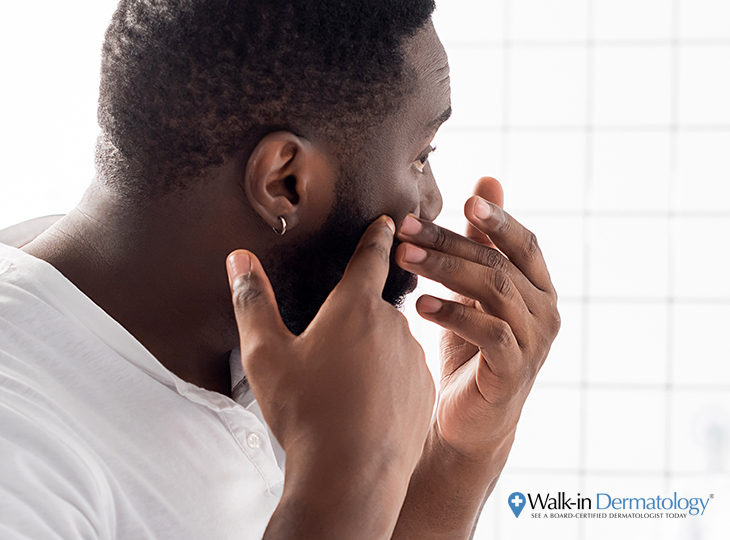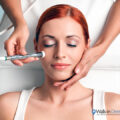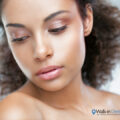Tues: 8:30am - 3:00pm
Wed: 12:00pm - 6:00pm
Thurs: 8:30am - 3:00pm
Fri: Closed
Sat: 8:30am - 12:30pm
Sun: Closed
Greenvale, NY 11548
Should You Pop Your Pimples?


Dermatologists will almost always discourage you from popping your own pimples. There are several reasons to keep your fingers off those bumps. First and most problematic is the risk of scarring or permanently damaging your skin. The contents of infected pimples can spread to other areas of your skin and worsen the condition.
Bacteria occurring naturally on your fingertips can also cause an infection where the skin is broken, which is unavoidable with do-it-yourself pimple popping. You can even end up pushing the contents of a pimple deeper into your skin, especially pimples that have not formed to a head. When this happens, you’re likely triggering inflammation that may cause discomfort, possibly pain and more reddening. Things just got worse.
A dermatologist will have sterilized tools specifically designed to pop pimples and extract blackheads. You might also be a suitable candidate for a cortisone shot, which can shrink pimples and remove their visible evidence far quicker than if you rupture your skin.
Yet in spite of medical advice and all the known risks, pimple popping continues. To be sure, popping a pimple provides instant gratification and may seem to solve the problem until a bruise forms around the pinched skin or the hole where the pimple used to be scabs over. Most people pop their pimples, anyway.
In fact, more than 8 in 10 American women admit they pop their pimples, according to a recent survey of 2,000 women by OnePoll on behalf of Truly Beauty. More than half (52 percent) say they pick at their face absentmindedly, without realizing what they’re doing. The survey found that women pop an average of 65 pimples a year. So if a girl develops her first pimple at 13 and never sees another after age 55, that’s still 2,730 popped pimples over most of her lifetime. Stress triggers hormonal reactions that can cause pimples to form. Women responding to the OnePoll survey say they feel stress to have perfect skin, thanks to the relentless pressure of social media and having been cooped up for more than a year due to the pandemic. That’s just a vicious cycle.
What to do?
Dermatologists say every time people pop pimples they run the risk of harming their skin.
So the standard medical advice is to leave your pimples alone. Many acne-causing conditions can be treated with over-the-counter preparations, changes in diet and a good skin-cleaning regimen. A dermatologist in some cases can give you a shot of a steroid hormone such as cortisone to shrink problematic pimples or use special tools to extract those unsightly blackheads safely.
Still, there is temptation. Pimples are uncomfortable. Unattractive. And when pimples appear right before a big event they are just plain infuriating.
So if you must pop that pimple, consider these tips to proceed safely while minimizing skin damage.
First, let’s distinguish between whiteheads and blackheads. Whiteheads are enclosed under the skin and when fully formed will present a white blob at the tip. Blackheads are clogged pores filled with dead skin cells and the body’s natural oils. These pimples are exposed to air, which is why they turn black.
Wiping out whiteheads
If you’re dealing with a whitehead, wait as long as possible until it looks like it’s ready to pop on its own. Wash your hands and especially fingers in hot, soapy water. An additional spritz of hand sanitizer is even better. Now, hold a cotton ball between your thumb and index finger on each hand. Use the cotton balls to press gently against the sides of the pimple, working in a circular motion. If the contents do not come out almost immediately, stop and wait until the pimple is ready. A hot compress may help bring the pimple to the surface.
Be gone, blackheads
Blackheads are often removed with a tool known as a comedone extractor. Resembling a thin metal wand with a loop on one end, these tools are available at pharmacies and online. The loop on the end of the extractor is positioned over the blackhead. Gentle pressure forces the plug out of the skin pore so it can be removed. Blackheads that extend slightly above the skin are usually easier to remove. Dip the extractor in rubbing alcohol before touching any area of your skin.
As with any pressure applied to your face, bruising your skin is one risk of using a comedone extractor. Large or stuck blackheads may require other procedures for safe removal, so again, your best course of action is to see a dermatologist.
Pimples you should not attempt to pop:
- Cysts. These are infected and often painful red lumps under the skin.
- Nodules: Swollen, hard lumps deep in the skin.
- Papules: Purple or red bumps without a whitehead.
- Pustules: Visible bumps that may feel warm to the touch. These bumps are also infected and will often be surrounded by red or purple skin.
These types of pimples are best left to a dermatologist for treatment to reduce the risk of spreading infection and worsening your acne condition. Prescription medicines, including antibiotics, may also be required.
If you have a big event coming up fast, consider whether the pimple could be obscured with an application of makeup until you can see a professional. It’s really not worth it to pop the pimple today and deal with a scar forever.
Persistent acne can sometimes be treated successfully with benzoyl peroxide and salicylic acid, both available in over-the-counter preparations. Changes in diet can also help. Sugary foods, dairy products, and greasy foods can all trigger an acne outbreak. For chronic conditions, your dermatologist can advise on procedures such as skin peels, steroid injections and prescription-strength medications to eradicate acne. You should also see a dermatologist to go over treatments for reducing and even eliminating scars and blemishes that have already occurred from popping those pimples.
Let Walk-in Dermatology Take Care of You and Your Skin
If you require pimple treatment fast and the stress of needing it is just making things worse, you don’t have to worry or wait. Walk-in Dermatology is here to keep you healthy. Our team of board-certified dermatologists and experienced medical staff will address your concerns and provide the necessary care for all your skin conditions. You can also schedule an appointment with us online.
If you can’t make it to one of our offices, we can set up a Video Visit and even prescribe medications remotely. Contact us today.








